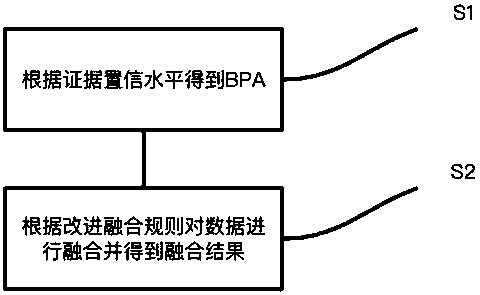Power operation and maintenance alarm data fusion method based on evidence theory
A technology of data fusion and evidence theory, applied in the direction of instruments, character and pattern recognition, computer components, etc., can solve the problems of uncertain results, uncertainties, failure to consider evidence conflicts of identification frameworks and normalization steps, etc. Achieve improved efficiency and improved accuracy
- Summary
- Abstract
- Description
- Claims
- Application Information
AI Technical Summary
Problems solved by technology
Method used
Image
Examples
Embodiment 1
[0038] Example 1: Complete Conflict Evidence:
[0039] Assuming that the identification framework is Θ={A, B, C}, there are four evidence source data, and BPA is expressed as follows:
[0040]
[0041] Among them, the evidence m 1 and m 2 for complete conflict evidence. In the traditional DS combination rules, this situation cannot be calculated. However, according to the calculation method in this paper, the fusion result can be obtained as follows:
[0042] m(A)=0.912, m(B)=0.044, m(C)=0.044.
Embodiment 2
[0043] Example 2: Zero Trust Paradox:
[0044] Assuming that the identification framework is Θ={A, B, C}, there are four evidence source data, and BPA is expressed as follows:
[0045]
[0046] Through calculation, the total conflict coefficient of the four evidences is k=0.99, and the DS combination rule is used for fusion, and the fusion result is:
[0047] m(A)=0, m(B)=0.727, m(C)=0.273,
[0048] Evidence m 2 Completely negate proposition A, so no matter how much other pieces of evidence support proposition A, the support degree of proposition A in the composite result obtained is always 0. However, through the method of this paper for fusion, the obtained fusion result is:
[0049] m(A)=0.5153, m(B)=0.2363, m(C)=0.2484.
Embodiment 3
[0050] Embodiment 3: A paradox of trust:
[0051] Assuming that the identification framework is Θ={A, B, C}, there are four evidence source data, and BPA is expressed as follows:
[0052]
[0053] By calculation, according to The total conflict coefficient of the four pieces of evidence is k=0.9998, and the DS combination rule is used for fusion, and the fusion result is:
[0054] m(A)=0, m(B)=1, m(C)=0,
[0055] It can be seen that the BPA assigned to Proposition B by all the evidence is very small, but the result obtained is that Proposition B is fully supported, which is contrary to common sense in practical applications. Through the method of this paper, the fusion results are as follows:
[0056] m(A)=0.070, m(B)=0.061, m(C)=0.869.
PUM
 Login to View More
Login to View More Abstract
Description
Claims
Application Information
 Login to View More
Login to View More - R&D
- Intellectual Property
- Life Sciences
- Materials
- Tech Scout
- Unparalleled Data Quality
- Higher Quality Content
- 60% Fewer Hallucinations
Browse by: Latest US Patents, China's latest patents, Technical Efficacy Thesaurus, Application Domain, Technology Topic, Popular Technical Reports.
© 2025 PatSnap. All rights reserved.Legal|Privacy policy|Modern Slavery Act Transparency Statement|Sitemap|About US| Contact US: help@patsnap.com



